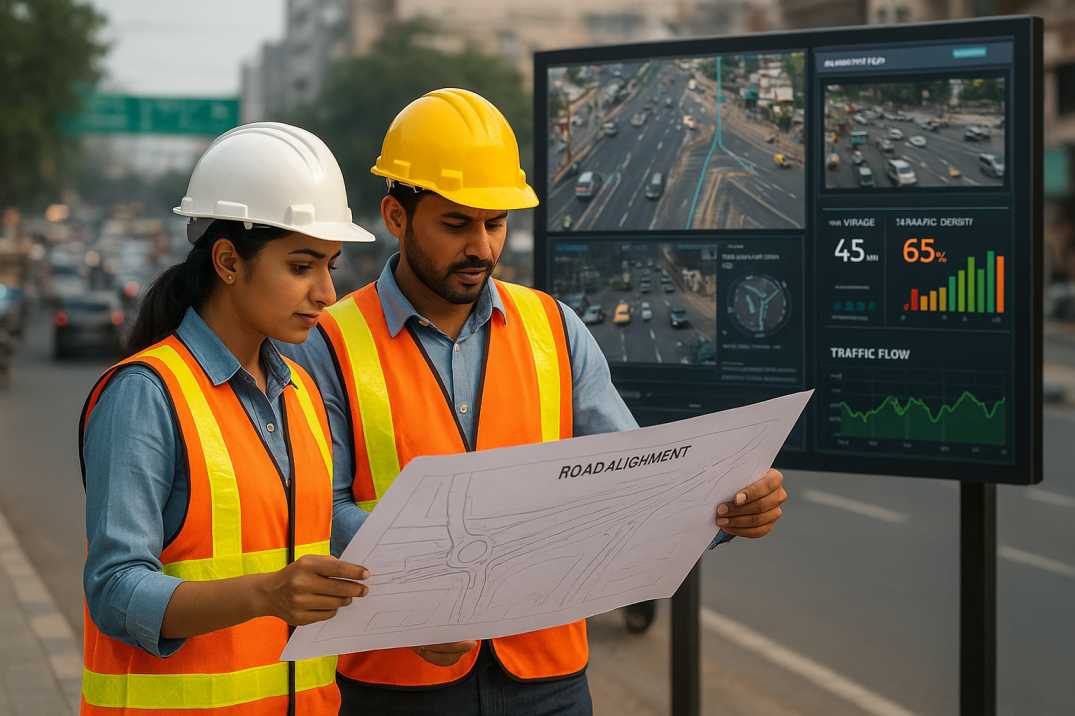Contact Us
RoadVision AI
Private Limited
Office No. 308 & 310, B Block
Ansal Chamber - 1, Bhikaji Cama Place,
Near Engineers India Limited (EIL) Bhawan, New Delhi - 110066
© 2024 | RoadVision AI | All rights reserved
Urban India is facing rising challenges of congestion, safety risks, and infrastructure strain. Effective traffic congestion solutions India require both strong design standards and modern technology. The IRC 86 standard, officially known as IRC:86-2018 Geometric Design Standards for Urban Roads and Streets, plays a crucial role in shaping safer, more efficient roads. When combined with road asset management India and AI-based traffic monitoring, it can deliver long-lasting traffic flow improvement in Indian cities.
The integration of these standards with the services provided by the best AI road asset management company in India, such as pavement condition survey, road safety audit, and road inventory inspection, ensures that India’s urban roads are not just designed well, but also monitored and maintained effectively.

Indian roads face a unique mix of traffic: cars, buses, auto-rickshaws, two-wheelers, pedestrians, and non-motorized transport. Without clear standards, roads become bottlenecked, unsafe, and inefficient. IRC:86-2018 geometric design guidelines provide a systematic framework for road hierarchy, lane design, pedestrian access, and intersection control.
These guidelines are not stand-alone solutions. They work best when paired with continuous monitoring from AI-based traffic monitoring and insights from road asset management India to ensure compliance, identify stress points, and schedule timely interventions.
The standard classifies roads into urban expressways, arterials, sub-arterials, collector streets, and local streets. Each is assigned a design speed appropriate to terrain and function. This ensures that traffic flows consistently without abrupt speed changes that often cause congestion.
IRC:86 specifies minimum right-of-way (ROW) widths and prescribes allocation for carriageways, medians, footpaths, and non-motorized tracks. Dedicated pedestrian zones (minimum 1.8 m width) and safe cycle paths reduce conflicts and allow vehicles to move without interruption.
Smooth horizontal and vertical alignment with proper transition curves, superelevation, and widening reduces sudden braking and unpredictable lane changes. This creates steadier flows and reduces accident risks.
Adequate stopping sight distance ensures drivers can anticipate hazards and react safely. Safer driving patterns also mean less sudden congestion.
The standard emphasizes footpaths, crossings, and NMT corridors. By providing safe zones for non-motorized users, vehicular traffic lanes are freed from unpredictable disruptions.
When these elements are backed by road asset management India and AI-based traffic monitoring, cities can maintain flow consistently over time.
Geometric standards provide structure, but their effectiveness depends on active monitoring and maintenance. That’s where modern solutions come in:
Together, these services make the best AI road asset management company in India an essential partner for cities aiming at congestion-free mobility.
The IRC:86-2018 geometric design guidelines are a vital foundation for efficient urban road systems in India. But to truly unlock traffic flow improvement in Indian cities, they must be integrated with modern technology—especially AI-based traffic monitoring and road asset management India. Companies like RoadVision combine design compliance with data-driven monitoring to ensure roads stay safe, efficient, and sustainable.
RoadVision AI is revolutionizing road infrastructure development and maintenance with its innovative solutions powered by computer vision AI. By leveraging advanced technologies, the platform conducts comprehensive road condition monitoring and traffic surveys, enabling early detection of surface issues like potholes and cracks for timely repairs and enhanced roads. Through traffic congestion analysis, RoadVision AI provides data-driven insights to address traffic congestion challenges and optimize road usage. With a focus on building smarter and more efficient road infrastructure, RoadVision AI ensures full compliance with IRC Codes, helping engineers and stakeholders reduce costs, minimize risks, and improve road safety and transportation efficiency.
Want to see how these solutions can transform your city’s roads? Book a demo with us today.
Q1. What is the purpose of IRC:86-2018 guidelines?
They set standards for urban road design, ensuring consistency, safety, and improved traffic flow in Indian cities.
Q2. How does AI improve road asset management?
AI enables real-time traffic monitoring, predictive maintenance, and data-driven interventions, making asset management proactive and effective.
Q3. Why is pedestrian integration important in road design?
Dedicated pedestrian and NMT zones reduce conflict with vehicles, improving both safety and traffic flow.